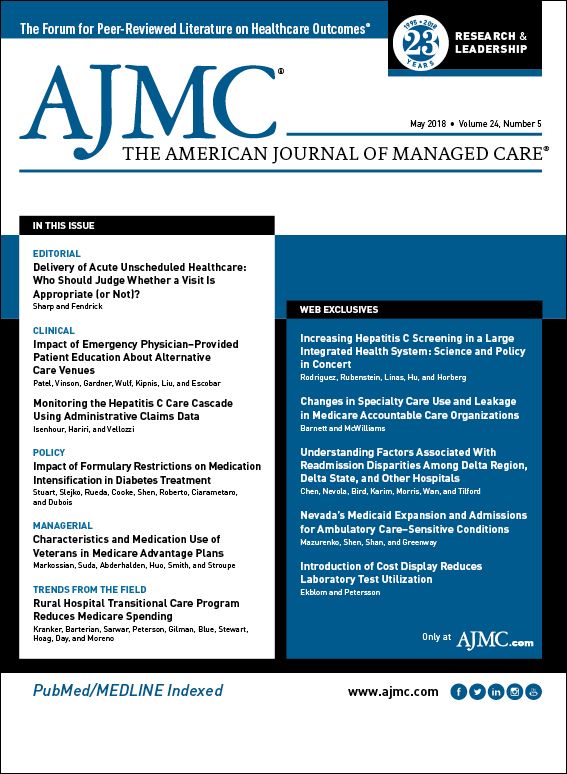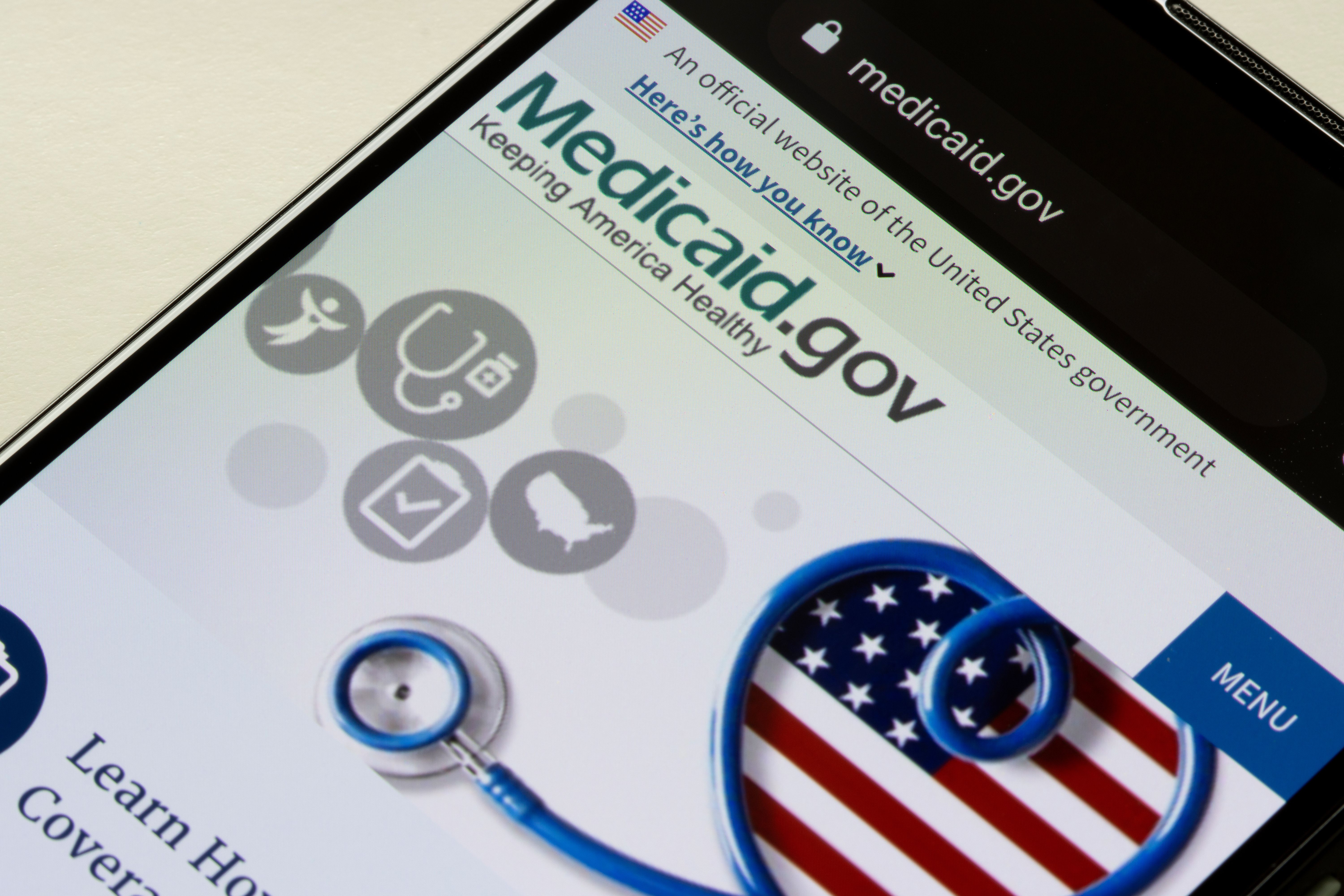Publication
Article
The American Journal of Managed Care
Rural Hospital Transitional Care Program Reduces Medicare Spending
Author(s):
A telephonic transitional care program at a rural hospital reduced postdischarge Medicare spending by 31% and reduced inpatient spending for Medicare fee-for-service beneficiaries.
ABSTRACT
Objectives: To evaluate impacts of a telephonic transitional care program on service use and spending for Medicare fee-for-service beneficiaries at a rural hospital.
Study Design: Observational cohort study.
Methods: Patients discharged from Atlantic General Hospital (AGH) with an AGH primary care provider were assigned a nurse care coordinator for 30 days. The nurse reviewed the patient’s conditions, assessed needs for transition support, conducted weekly telephone calls (beginning 24-72 hours after discharge) to monitor adherence to treatment plans, and scheduled follow-up appointments. Using claims data, we evaluated impacts on service use and spending using a difference-in-differences design with a matched comparison group.
Results: The intervention reduced Medicare spending in the 6-month period after discharge by 30.8%, or $1333 per beneficiary per month (90% CI, —$2078 to –$589), which was partly driven by a 39.4% reduction in spending for inpatient claims (difference, –$729; 90% CI, –$1234 to –$225). There were no statistically significant changes in the 14-day ambulatory care follow-up rate, 30-day unplanned readmission rate, number of inpatient admissions, or number of emergency department visits, although this may be due to modest statistical power to detect effects.
Conclusions: The estimated $5.4 million in savings from this intervention more than offset the costs of the $1.1 million funding for the award. Although other studies have found that care transitions programs can improve outcomes, this study was unique in the size of the impacts relative to the low-touch intervention and the location in a small rural healthcare system.
Am J Manag Care. 2018;24(5):256-260Takeaway Points
A telephonic transitional care program at a rural hospital reduced postdischarge Medicare spending and inpatient spending for Medicare fee-for-service beneficiaries.
- Healthcare decision makers seek to identify ways to deliver better healthcare at lower costs to beneficiaries with high healthcare needs, including patients recently discharged from a hospital.
- Small rural community-based hospitals have the ability to reduce posthospitalization spending and healthcare use.
- The estimated $5.4 million in savings from this transitional care program well exceeded CMS’ $1.1 million costs for the award.
- This promising program model merits further testing.
CMS seeks to identify ways to deliver better healthcare, improve health, and lower costs for beneficiaries of its programs, particularly those with the highest healthcare needs.1 One promising approach toward achieving this goal is transitional care, which encompasses a range of services provided to patients as they transfer across settings or levels of care to improve outcomes and avoid preventable hospitalizations, readmissions, and emergency department (ED) visits.2 Transitional care interventions vary in the populations they target, the services they provide, the types of providers delivering services, and the duration of support. Intervention components typically include patient or caregiver education, discharge planning, scheduling postdischarge appointments, monitoring a patient’s condition and adherence to the discharge plan, medication reconciliation, and coordination among health professionals involved in the transition.3-5
Prior studies have found that care transitions programs can improve patients’ outcomes.4-7 However, there is limited evidence on which interventions work best in different settings,3,4 and transitional care interventions at stand-alone community hospitals might not always achieve their goals.8 Further, lower rates of follow-up care and greater risk of ED visits for postdischarge Medicare beneficiaries in rural settings, compared with urban beneficiaries, highlight the need for policies that increase follow-up care in rural settings.9,10 Testing of transitional care programs in rural settings is needed.4
This study examined how a telephonic transitional care intervention for patients discharged from the hospital affected service use and Medicare spending in a small rural healthcare system.
METHODS
Using an observational cohort design, we evaluated the intervention’s effects on service use and spending among Medicare fee-for-service (FFS) beneficiaries using difference-in-differences (DID) design with a matched comparison group.
Setting
Atlantic General Hospital (AGH) is a private, not-for-profit, community-based healthcare delivery system with a 62-bed hospital and 7 primary care practices. AGH is located in Worcester County, Maryland, a largely rural county and a federally designated medically underserved area. Although the hospital is located in a resort area, most of AGH’s primary care patients live there year-round. AGH program administrators note that many residents are older than 65 years and have low levels of literacy.
Intervention
In July 2012, AGH received $1.1 million in Health Care Innovation Award (HCIA) funding from CMS’ Center for Medicare & Medicaid Innovation (CMMI) to implement a patient-centered medical home model that included a care transitions program.11 The program aimed to reduce 30-day readmissions and healthcare costs and targeted patients discharged from AGH who had any diagnosis and an AGH primary care provider (PCP). The program employed 1 full-time nurse care coordinator with extensive clinical and case management experience who managed a caseload of 40 to 50 patients at any given time.
The nurse monitored the hospital’s daily census to identify eligible patients. Using AGH’s electronic health record system, the nurse reviewed patient information, including reason for the hospital stay, recent primary care visits, and discharge instructions, and notified the patient’s AGH PCP of the admission. The nurse visited patients in the hospital to describe the program and identify postdischarge needs. She later called patients at home within 24 to 72 hours of discharge to enroll them in the program. (Participation was voluntary; 10% of patients opted out or could not be reached by phone after 3 tries.) During the initial call, the nurse reviewed the patient’s conditions, reconciled medications and identified barriers to medication compliance, identified immediate needs for support and barriers to self-care, and scheduled follow-up appointments with the AGH PCP. Thereafter, the nurse called participants weekly to monitor their conditions and compliance with postdischarge treatment plans. Participants with unstable conditions based on the nurse’s clinical judgment or who needed additional support received more frequent calls to address emerging needs in a timely manner. In rare cases, the nurse contacted the participant’s PCP regarding urgent needs and coordinated additional office visits or referrals. Patients left the transitional care program within 30 days after discharge from the hospital.
Population
The treatment group for our analysis included 638 Medicare FFS patients who had an AGH PCP and were discharged from AGH during the HCIA funding period (February 2013-May 2015). We defined the treatment group using intent-to-treat criteria and thus included some patients who did not participate in the program because they declined to participate or could not be reached by the care transitions care coordinator after 3 attempts. (Data indicate that 396 of the treatment group members, or 62%, were actually enrolled in the intervention.) eAppendices A and B (available at ajmc.com) provide additional details on sample selection, data availability, and sample sizes. The intervention also targeted other patients, including those enrolled in Medicaid, Medicare managed care, or commercial insurance, but data limitations precluded them from being included in the study.
Each treatment beneficiary was matched to 1 to 4 comparison beneficiaries. The comparison group was selected using exact matching and propensity score matching techniques,12 and it included 2232 FFS Medicare beneficiaries who were discharged during the same time frame from either Peninsula Regional Medical Center (PRMC) or AGH but did not have an AGH provider (so the beneficiaries were not contacted by the nurse care coordinator). PRMC is a larger hospital than AGH, but it was selected as a comparison because it is located just 30 miles from AGH in Salisbury, Maryland, a city of about 30,000; participated in Maryland’s global payment model, like AGH; and did not implement the care transitions component.
To support the DID analyses, we also measured outcomes for 226 patients with an AGH PCP who were discharged from AGH in a 1-year period before the intervention began (July 2011-June 2012) and 1008 matched comparison beneficiaries from the same time frame. The pre- and postintervention cohorts included different patients—a potential study limitation.
Data and Outcomes
Using Medicare FFS parts A and B claims data, we measured 5 outcomes: (1) the percentage of beneficiaries with an ambulatory care follow-up visit with a primary care or specialist physician within 14 days of the discharge that qualified the patient for the treatment or comparison group, (2) the percentage of beneficiaries with an unplanned readmission within 30 days of discharge, (3) the average number of all-cause readmissions within 6 months after discharge, (4) the average number of outpatient ED visits within 6 months after discharge, and (5) average Medicare parts A and B spending in the 6 months after discharge. These 5 confirmatory outcomes were prespecified based on being of the highest interest to CMMI. We later added 2 exploratory outcomes: average inpatient and noninpatient Medicare spending.
Statistical Analyses
Impact estimates measured the differences in postdischarge outcomes between the treatment group patients during the intervention period and matched comparison beneficiaries, minus the differences in postdischarge outcomes between treatment group patients discharged in a 1-year period before the intervention began and matched comparison beneficiaries.
We used linear regression models to implement the DID framework, adjusting for patient-level covariates. The covariates included patients’ demographics, chronic conditions, and service use and spending 0 to 3 months and 4 to 12 months before enrollment, as well as indicators for each matched set and treatment status. The DID estimate was the coefficient for an interaction of a beneficiary’s treatment status with an indicator for being in the postintervention cohort. Weighted regression models were estimated to account for many-to-one matching, and inference was based on bootstrap standard errors. See eAppendix A for additional details.
RESULTS
Some baseline characteristics of the 638 Medicare FFS beneficiaries in the postintervention treatment group, such as gender and age, were similar to benchmarks for the national Medicare population, but other characteristics indicate that the treatment group had more healthcare needs than the general population (eAppendix C). The Hierarchical Condition Category risk score for the treatment group was 2.47, indicating that the group could be expected to have Medicare spending more than double the national average over the next year.13 The prevalence of chronic obstructive pulmonary disease, chronic kidney disease, and congestive heart failure in the treatment group was more than twice the national average. Treatment group members also had high service use and spending. The treatment group beneficiaries had, on average, 1092 hospitalizations and 406 ED visits per 1000 beneficiaries, and their Medicare spending averaged $6603 per month in the quarter before enrollment.
In both the pre- and postintervention cohorts, the treatment and comparison beneficiaries were well matched on individual-level characteristics at baseline, including demographics, health status, chronic conditions, reason for the hospitalization leading to eligibility for enrollment in the care transitions program, and health service use and spending 1 year before discharge (eAppendix C).
As shown in the Table, the follow-up ambulatory care visit rate in the 14 days following discharge was 73.5%, 5.9 percentage points higher than the regression-adjusted rate for the comparison group. This DID estimate was not statistically significant (90% CI, —1.6 to 13.4; P = .194).
The treatment group’s 30-day unplanned readmission rate following discharge was 11.6%, 1.9 percentage points higher than the comparison group’s after regression adjustment. This was a large difference (18.9%), but the large standard error means that the unfavorable impact was estimated imprecisely (90% CI, —3.6 to 7.3; P = .578).
The treatment group averaged 229 all-cause inpatient admissions per 1000 beneficiaries per quarter over the first 2 quarters following the beneficiary’s qualifying discharge, which was estimated to be 72 admissions fewer than the comparison group (90% CI, —149 to 4; P = .121), a statistically insignificant difference of about 24%.
The treatment group rate of outpatient ED visits within 6 months after discharge was similar to the comparison group rate (after regression adjustment); however, the DID was not estimated precisely (difference, —19; 90% CI, –111 to 73; P = .735).
Medicare parts A and B spending for the treatment group averaged $2992 per beneficiary per month over the first 2 quarters following the beneficiary’s discharge, which was estimated to be $1333 lower than regression-adjusted spending for the comparison group. This DID estimate is statistically significant (90% CI, —$2078 to –$589; P = .003) and large (31% lower than the adjusted comparison group’s spending). The treatment group’s spending was higher than the comparison group’s during the preintervention period, but lower in the intervention period, leading to the large DID estimate.
Decreases in spending for inpatient claims accounted for 55% of the reduction in total spending. Specifically, regression-adjusted inpatient spending was $729 lower than the comparison group’s spending (90% CI, —$1234 to –$225; P = .017), whereas spending for noninpatient claims was $604 lower (90% CI, —$968 to –$239; P = .006).
CONCLUSIONS
This telephonic intervention decreased Medicare parts A and B spending substantially (by nearly one-third) during the first 6 months after beneficiaries’ enrollment, driven in part by a decrease in inpatient spending. AGH expected cost reductions to occur through decreases in the readmission rate and the number of ED visits, and it set a goal to obtain a 20% reduction for these 2 measures. However, tests for these outcomes, as well as for a decrease in the number of admissions and an increase in the rate of ambulatory care follow-up within 14 days of discharge, did not yield statistically significant results. The lack of observed effects may be due to imprecision in the estimates; AGH’s expected impacts fall within the 90% CIs.
Although other studies have found that care transitions programs can improve outcomes, this study was unique in both the size of the impacts relative to the low-touch (and low-cost) telephonic intervention and the location in a small rural healthcare system—a setting not often represented in such studies. The estimated $5.4 million in savings from the transitional care component well exceeded the $1.1 million HCIA award. The effects coincided with successful implementation of the program, including process improvements throughout the program to accommodate patients’ needs. Thus, this promising program model merits further testing, and hospitals looking to implement a care transitions program, particularly in a rural setting, might consider implementing AGH’s program model. 
Acknowledgments
Many individuals contributed to this study. The authors would specifically like to acknowledge the important contributions to this report made by Andrew McGuirk, Sandi Nelson, Ken Peckham, and Lauren Vollmer of Mathematica Policy Research, who skillfully processed and helped analyze Medicare claims and enrollment data.Author Affiliations: Mathematica Policy Research (KK, LMB, RS, GGP, BG, LB, KAS, SDH, LM), Ann Arbor, MI, Cambridge, MA, Princeton, NJ, and Washington, DC; Center for Medicare & Medicaid Innovation (CMMI), CMS (TJD), Baltimore, MD.
Source of Funding: Evaluation funded by CMS, CMMI, contract number HHSM-500-2010-000261/HHSM-500-T0015. The contents of this publication are solely the responsibility of the authors and do not necessarily represent the official views of HHS or any of its agencies.
Author Disclosures: The authors report no relationship or financial interest with any entity that would pose a conflict of interest with the subject matter of this article.
Authorship Information: Concept and design (KK, LMB, GGP, BG, LB, KAS, TJD, LM); acquisition of data (RS); analysis and interpretation of data (KK, LMB, RS, GGP, BG, LB, KAS, SDH); drafting of the manuscript (KK, LMB, RS, GGP, SDH); critical revision of the manuscript for important intellectual content (KK, LMB, GGP, SDH, TJD, LM); statistical analysis (KK); obtaining funding (BG, LM); administrative, technical, or logistic support (KK, GGP, BG, LB, KAS, TJD, LM); and supervision (KK, GGP, LM).
Address Correspondence to: Keith Kranker, PhD, Mathematica Policy Research, PO Box 2393, Princeton, NJ 08543-2393. Email: kkranker@mathematica-mpr.com.REFERENCES
1. Health Care Innovation Challenge: cooperative agreement: initial announcement. CMS website. innovation.cms.gov/Files/x/Health-Care-Innovation-Challenge-Funding-Opportunity-Announcement.pdf. Published November 14, 2011. Accessed April 2, 2018.
2. Coleman EA, Boult C; American Geriatrics Society Health Care Systems Committee. Improving the quality of transitional care for persons with complex care needs. J Am Geriatr Soc. 2003;51(4):556-557. doi: 10.1046/j.1532-5415.2003.51186.x.
3. Hansen LO, Young RS, Hinami K, Leung A, Williams MV. Interventions to reduce 30-day rehospitalization: a systematic review. Ann Intern Med. 2011;155(8):520-528. doi: 10.7326/0003-4819-155-8-201110180-00008.
4. Peikes D, Lester RS, Gilman B, Brown R. The effects of transitional care models on re-admissions: a review of the current evidence. Generations. 2012;36(4):44-55.
5. Feltner C, Jones CD, Cené CW, et al. Transitional care interventions to prevent readmissions for persons with heart failure: a systematic review and meta-analysis. Ann Intern Med. 2014;160(11):774-784. doi: 10.7326/M14-0083.
6. Phillips CO, Wright SM, Kern DE, Singa RM, Shepperd S, Rubin HR. Comprehensive discharge planning with postdischarge support for older patients with congestive heart failure: a meta-analysis. JAMA. 2004;291(11):1358-1367. doi: 10.1001/jama.291.11.1358.
7. Vedel I, Khanassov V. Transitional care for patients with congestive heart failure: a systematic review and meta-analysis. Ann Fam Med. 2015;13(6):562-571. doi: 10.1370/afm.1844.
8. Linden A, Butterworth SW. A comprehensive hospital-based intervention to reduce readmissions for chronically ill patients: a randomized controlled trial. Am J Manag Care. 2014;20(10):783-792.
9. Toth M, Holmes M, Van Houtven C, Toles M, Weinberger M, Silberman P. Rural Medicare beneficiaries have fewer follow-up visits and greater emergency department use postdischarge. Med Care. 2015;53(9):800-808. doi: 10.1097/MLR.0000000000000401.
10. Kind AJ, Jensen L, Barczi S, et al. Low-cost transitional care with nurse managers making mostly phone contact with patients cut rehospitalization at a VA hospital. Health Aff (Millwood). 2012;31(12):2659-2668. doi: 10.1377/hlthaff.2012.0366.
11. Gilman B, Hoag S, Moreno L, et al. Evaluation of Health Care Innovation Awards (HCIA): Primary Care Redesign Programs: First Annual Report. Princeton, NJ: Mathematica Policy Research; 2014. CMS website. innovation.cms.gov/Files/reports/HCIA-PCRP-FirstEvalRpt.pdf. Accessed December 15, 2016.
12. Hansen BB. Full matching in an observational study of coaching for the SAT. J Am Stat Assoc. 2004;99(467):609-618. doi: 10.1198/016214504000000647.
13. Pope GC, Kautter J, Ellis RP, et al. Risk adjustment of Medicare capitation payments using the CMS-HCC model. Health Care Financ Rev. 2004;25(4):119-141.






